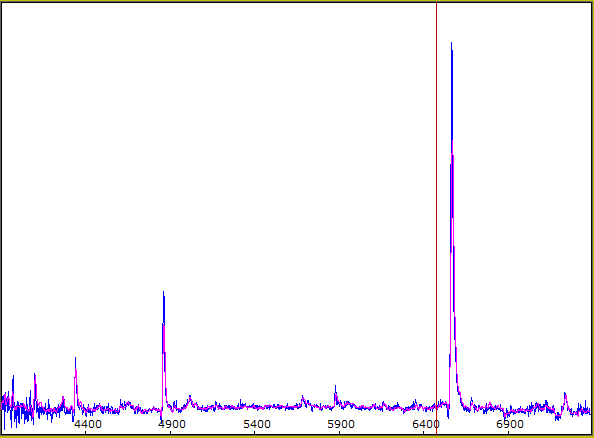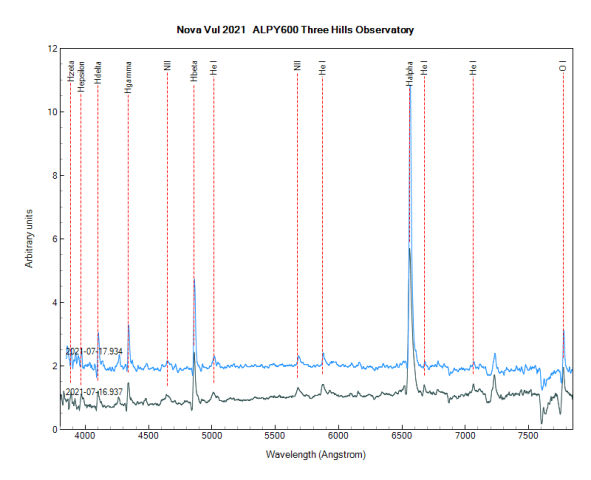Forum Replies Created
-
AuthorPosts
-
 Robin LeadbeaterParticipant
Robin LeadbeaterParticipantThanks David. Excellent reproducibility between our spectra taken less than an hour apart though my ALPY spectrum (in pink) is lower resolution of course.
Cheers
Robin

 Robin LeadbeaterParticipant
Robin LeadbeaterParticipantSpectra from the past two nights. (The first predates the one in the ATel by 4 hours) I have marked the main lines but there are a few currently unidentified. Suggestions welcome

 Robin LeadbeaterParticipant
Robin LeadbeaterParticipantA Low resolution (R~500) spectrum taken just now (20210716.915) shows strong H Balmer P Cygni profile emission lines with a velocity of ~1400km/s and other broad emission lines including He. (Looks like it is a Nova)
https://britastro.org/specdb/data_graph.php?obs_id=10094
Continuing to take spectra.
Robin
 Robin LeadbeaterParticipant
Robin LeadbeaterParticipantSome more examples
http://www.astrosurf.com/buil/forum18/_transmission_TELESCOPE.png
From a thread entitled ” A la recherche des photons perdus”
https://www.spectro-aras.com/forum/viewtopic.php?f=45&t=2277
 Robin LeadbeaterParticipant
Robin LeadbeaterParticipantThere have indeed been various discussions on the ARAS spectroscopy forum about some modern coatings (on mirrors, lenses and camera windows) which while very efficient in the visible, drop off rapidly in the UV, for example this plot for the GSO RC telescope which effectively cuts off steeply at 4000A
https://www.spectro-aras.com/forum/viewtopic.php?f=45&t=2398&p=13202#p13470
This has been a big issue for the UVEX spectrograph, summed up by Christian Buil in the same thread
“What always worries me is to see reflectivity of 99%, via dielectric treatments. These things are really our enemies in spectrography when we want to go to slightly extreme wavelengths. Besides that 99%, it is only for a narrow area of the spectrum – it is misleading. Long live the coating with a single protective layer, even if we are at 96% reflection in the visible.” Robin LeadbeaterParticipant
Robin LeadbeaterParticipantThe effect of an off axis stop is an interesting one. The star image size will remain the same (assuming seeing limited) so the maximum theoretical resolution is unchanged. The defocussing effect of field curvature should be less due to the increased depth of field with the higher focal ratio and the chromatic coma should also be less with the less steeply convergent beam. I did suggest this to someone recently though in a similar situation and they reported no obvious improvement. Best approach I would say is to see what you can get on the existing setup and then try a stopped down aperture. (What spacing do you have currently?)
 Robin LeadbeaterParticipant
Robin LeadbeaterParticipantIf you are limited in how far away you can mount the grating then the SA200 can give you the dispersion you need for useful resolution but it does not quite match the SA100 at double the distance. The field curvature is also more severe and you can see this in your spectrum as it widens towards the red end. Getting the best result is a compromise with what is a primitive setup but think of it as good inexpensive way to “cut your teeth” before upgrading to a “proper” spectrograph if the bug bites
 Robin LeadbeaterParticipant
Robin LeadbeaterParticipantSorry for any typos, I am on holiday and using a portable device. Normal service should be resumed next week.
 Robin LeadbeaterParticipant
Robin LeadbeaterParticipantYes it is standard practise to align and stack shorter exposures with slitless spectra (on the zero order image) as it avoids guiding, effectively using the same techniques as planetary imagers to select the sharpest images (but no further processing eg sharpening etc) modern CMOS also means the noise penalty is lower than with CCD
Cheers
Robin
 Robin LeadbeaterParticipant
Robin LeadbeaterParticipantAs a rough guide to what setups work I developed a simple calculator which is hosted on the Rspec website. (The Rspec software there is good for beginners using the Star analyser but you will outgrow it as you progress to more research based spectroscopy)
https://www.rspec-astro.com/calculator
There is a tutorial on the Star Analyser on the site here
https://www.britastro.org/downloads/15701
and if you are interested in its development, I talk about it here
https://britastro.org/video/11250/12234
Cheers
Robin
 Robin LeadbeaterParticipant
Robin LeadbeaterParticipantYou ar in the right place, I developed the Star Analyser
P Cygni is an excellent test target It shows nice clear emission lines of H and He, ideal to focus on (focus on the features in the spectrum, not on the zero order star image, noting that the field curvature, particularly with long spectra means that the focus will vary along the spectrum to some extent
http://www.threehillsobservatory.co.uk/astro/spectroscopy_16.htm#SA200_filter_wheel
16 inch is a big aperture for a slitless converging beam setup though unless the seeing is exceptional. The resolution is at best defined by the size of the star image relative to the length of the spectrum. The problem is as you increase the length of the spectrum the aberrations of the simple setup get worse and if you try to use a lower focal ratio to keep the star image small, the aberrations also get worse due to the steeply converging beam so these setups work best on modest apertures. give it a go though and I can help steer you to get the best out of the setup
don’t worry too much about software at this stage, concentrate on getting a clear image. It is a low resolution “broad brush” type of device and most of the interesting features the Star Analyser are immediately visible. This is an example of the sort of features you should be able to pick up.
https://britastro.org/observations/observation.php?id=20201216_234948_8cabda965bfe692f
Cheers
Robin
 Robin LeadbeaterParticipant
Robin LeadbeaterParticipantA nice collection of spectra building up here in the Spectroscopy Database showing the evolution
The shift in the H alpha line from predominantly blue to red while still centred on the rest wavelength is curious. I wonder what that means physically
Cheers
Robin
 Robin LeadbeaterParticipant
Robin LeadbeaterParticipantProf Steve Shore comments on the evolution of Nova Del 2013 based on amateur spectra here. Not simple though !
http://www.astrosurf.com/aras/novae/Nova2013Del-1.html
Cheers
robin
 Robin LeadbeaterParticipant
Robin LeadbeaterParticipantVery broad P Cygni H and He by the looks. Almost overlapping with the high velocity. Almost a supernova like spectrum
 Robin LeadbeaterParticipant
Robin LeadbeaterParticipantIntriguingly a low resolution Star Analyser spectrum by Rob Kaufman in Australia earlier today failed to show any significant emission
After clear blue skies all afternoon the clouds have rolled in here but no doubt we will have better spectra tonight
 Robin LeadbeaterParticipant
Robin LeadbeaterParticipantWhile watching the recent partial eclipse in largely cloudy skies I wondered if it might be possible to follow an eclipse even in cloudy conditions in spectra of the sky. The shape of the spectrum line profiles should alter slightly as different parts of the rotating solar disc are covered. (Similar to the Rossiter-McLaughlin effect see in the spectrum of eclipsing binaries) Does anyone know if this type of observation has ever been attempted ?
Cheers
Robin
 Robin LeadbeaterParticipant
Robin LeadbeaterParticipantAgainst all odds there is actually intermittent sun here
 Robin LeadbeaterParticipant
Robin LeadbeaterParticipantHere are 6 spectra around that date from the BAA spectroscopy database (From David Boyd (2), Kevin Gurney, Hugh Allen, John Coffin and me)
They all line up in wavelength precisely
Cheers
Robin
 Robin LeadbeaterParticipant
Robin LeadbeaterParticipantIn fact I see further down the thread Hugh actually wavelength calibrated Mike’s prism spectrum to produce a graph of the spectrum with a linear wavelength axis.
https://britastro.org/comment/10463#comment-10463
You can see there that the wavelengths then agree in Mike’s Hugh’s and my spectra (and indeed with those by David Boyd and John Coffin in the same thread)
 Robin LeadbeaterParticipant
Robin LeadbeaterParticipantI just checked mine and Hugh’s spectra from 23rd March in the Nova Cas 2021 thread. The graphed spectra are calibrated in wavelength with a linear X axis and the Balmer (and other line) wavelengths are correct and consistent between the two spectra
https://britastro.org/comment/10272#comment-10272
https://britastro.org/comment/10277#comment-10277
Mike’s spectrum image is not calibrated in wavelength.
https://britastro.org/comment/10242#comment-10242
Prism spectra are very non linear with the short wavelength end significantly stretched and the longer wavelengths compressed
-
AuthorPosts
